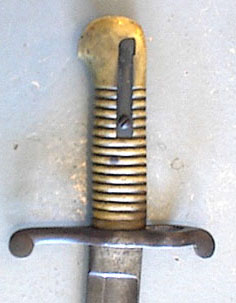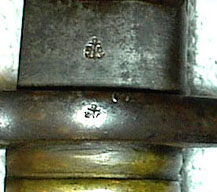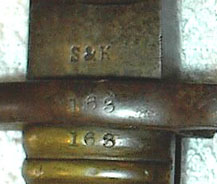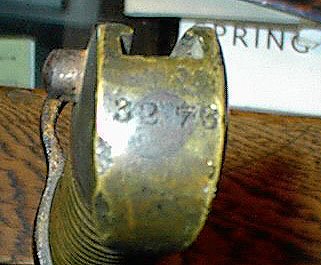"Revolving" Carbine
Artillery Model
Saber Bayonet
aka "Brazilian Naval Bayonet"

This sword bayonet was originally produced to fit the Brazilian Naval Rifle (almost identical
to the British Pattern 1856 Sergeant's Rifle, made in Liege, Belgium); also believed sold with the US Model 1855
Colt Revolving Artillery Carbine (of which perhaps no more than 200 of these carbines were made).
According to R.L. Wilson's The Book of Colt Firearms this was the "rarest
distinct variation in the carbine series." He further states that, "bayonets
measure 28-3/4" overall and are marked S&K (Schnitzler & Kirschbaum). They have
iron cross-guards and brass hilts. Locking stud and spring of iron. Blade
measured 24-5/16" in length by 1-1/8" in width. Some were marked F.H. on the ricasso,
instead of the marking noted above. Produced in Europe, probably Germany."
According to the Standard Catalog of Firearms by Ned Schwing & Herbert Houze "these Liege made
rifles were supposedly made for the Brazilian Government, but at the beginning of the American
Civil War they were diverted to the United States, about 10,000 being imported."
The overall length of this example is ~28-1/2" but it is quite obvious that
the tip has been impact blunted by ~1/4"; adding that back would show the overall
length was - at one time - ~28-3/4". The would make the only discrepancy - and I believe
Mr. Wilson may be in error - is the blade length. This example is ~23-3/4" in
length, but adding the blunted 1/4" back would make this exactly 24"; if you
also include the width of the cross-guard, which is ~5/16" thick, Wilson's
measurement is quite plausible.
Reference pages 198 and 199, illustration A.
Scabbards were of black leather body with brass throat and drag.




